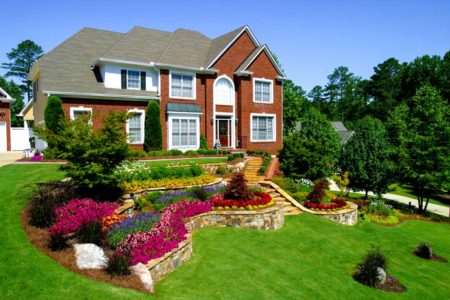When taking care of your lawn, it is always a good idea to be proactive. During the summer months, be on the lookout for these common signs indicating that your lawn needs to be refreshed and restored to its original condition.
Stress is typical during the hot summer months, especially in mid-July and August. If you notice a few brown spots on your lawn, chances are your grass didn’t have the necessary nutrients to survive the heat. A combination of fall aeration and overseeding will restore the soil and dill in with new seeds, so you don’t have bare spots.
When the soil under your turf becomes too hard, seeds won’t be able to penetrate and grow. Compacted soil chokes your lawn and doesn’t allow oxygen to circulate to the roots, making them vulnerable and your turf susceptible to diseases.
Thatch is the outer layer of dead and living plants that form around the grass. Excessive thatch can have a negative impact on the roots and your lawn in general. Thatch build-up creates a perfect environment for pests and fungi to reproduce and thrive. Thin layers of thatch build-up can be easily removed with a garden rake, but if the layers exceed one inch, a vertical mower or dethatching machine will be more practical.
Crabgrass and weeds take advantage of stresses or worn out lawns to reproduce all over your garden. Weeds compete with your grass plants for air and water, and if there are not enough nutrients, weeds will have a bigger chance of thriving.

Why Aerate and Over-seed Your Lawn in the Fall
Aeration is the process of creating tiny holes across your lawn. Over the summer months, the soil is compressed from high temperatures, excessive use, and hard rain, making it difficult for the roots of your grass to access air, water, and the necessary nutrients. Aeration solves this problem, digging thousands of small holes, allowing nutrients, fertilizer, and water to access your turf’s roots.
Fall aeration is vital to achieving a green and healthy lawn. If you want your garden to look its best, fall aeration should become an essential part of your lawn care and maintenance process.
In fact, fall overseeding and aeration are the best combo to give your turf the boost it needs to germinate and mature.
Overseeding is the process of planting grass seeds into your existing turf, without devastating the soil. From a professional point of view, it is one of the best ways to improve your grass’s color, fill in bare spots, and improve your turf’s overall health. After high summer temperatures, foot traffic, and lawn diseases, your yard may look work out. Following fall overseeding and aeration help thicken up the outer grass layer, reduce weed growth, enhance your lawn’s ability to protect itself from insects, and improve your yard’s appearance.
When to Consider Fall Aeration and Over-seeding
When taking care of your lawn, it is always a good idea to be proactive. During the summer months, be on the lookout for these common signs indicating that your lawn needs to be refreshed and restored to its original condition.
Dead or brown spots
Stress is typical during the hot summer months, especially in mid-July and August. If you notice a few brown spots on your lawn, chances are your grass didn’t have the necessary nutrients to survive the heat. A combination of fall aeration and overseeding will restore the soil and dill in with new seeds, so you don’t have bare spots.
Compacted soil
When the soil under your turf becomes too hard, seeds won’t be able to penetrate and grow. Compacted soil chokes your lawn and doesn’t allow oxygen to circulate to the roots, making them vulnerable and your turf susceptible to diseases.
Thatch build-up
Thatch is the outer layer of dead and living plants that form around the grass. Excessive thatch can have a negative impact on the roots and your lawn in general. Thatch build-up creates a perfect environment for pests and fungi to reproduce and thrive. Thin layers of thatch build-up can be easily removed with a garden rake, but if the layers exceed one inch, a vertical mower or dethatching machine will be more practical.
Invasive grasses and weeds
Crabgrass and weeds take advantage of stresses or worn out lawns to reproduce all over your garden. Weeds compete with your grass plants for air and water, and if there are not enough nutrients, weeds will have a bigger chance of thriving.
If you notice any of these common signs, you have to consider aeration and overseeding in the fall. It is the best way to get rid of invasive grasses, thatch build-up, and brown spots.
The Benefits of Fall Aeration and Over-seeding
Choosing to aerate and overseed in the fall has a number of benefits for your lawn.
Stimulates Fresh Growth
While grass can live for years, a fresh one is always welcomed. Without fresh grass, your lawn will look old and worn out, with bald patches in the corners. Aeration and overseeding take care of this problem by stimulating fresh growth of new and healthy grass and keeping your lawn green and healthy at all times.
Reduces Weeds
When you aerate and overseed, you give the roots air boost. The roots of your grass have more access to water, air, sun, and other nutrients necessary to expand through the soil. Invasive weeds won’t grow in a lawn that is full of healthy plants and strong roots.
Stronger Grass Roots
In early fall, your grass will start to slow its growth. However, if your soil is lush and productive, the roots will continue to grow. By helping the roots have access to water, air, and essential nutrients, you are helping them grow stronger and deeper into the ground. The deeper the roots, the more resilient the turf. The more resistant the turf, the lesser the weeds.
Resists Harsh Winter Temperatures
Lawns that are susceptible to diseases and invaded by weeds in the fall don’t survive the harsh winter temperatures, making it difficult and expensive to fix the damage. Even if you take care of the weeds and brown patches, it may take a few weeks for new turf to grow. In other words, you may need to invest in a couple of weeks of corrective methods to restore your lawn’s health.
Aerating and overseeding in the fall will prepare your lawn for the upcoming temperatures and set it up for progress once spring comes.













